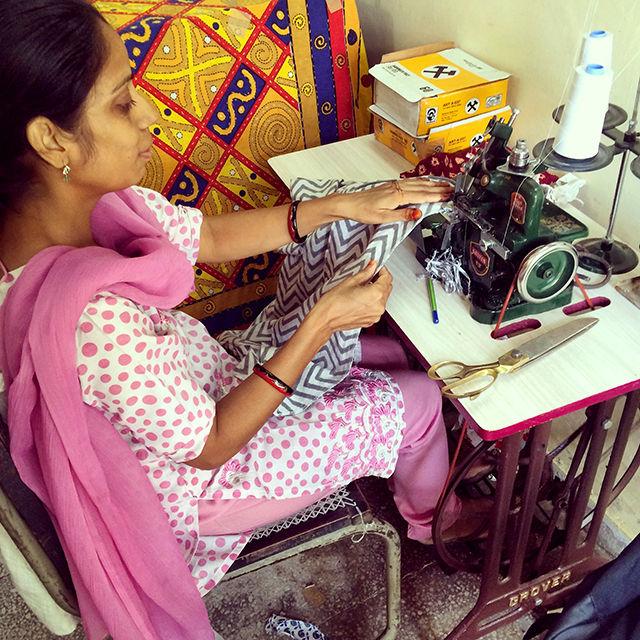The College of Textiles and the Association for India’s Development will host a fashion show featuring hand-printed, 100 percent cotton Indian garments made by underprivileged women in Jaipur, India, this Friday at 7 p.m.
The event will take place at the W. Duke Kimbrell Atrium Centennial Textiles Complex as part of a women’s empowerment project called the Hunar Revolution, according to Indian native and textile engineering chemistry and science professor Tushar Ghosh.
Ghosh said the pieces presented at the show will portray the struggle of underprivileged women and the role of nonprofits in India. Attendees can purchase the items after the show.
“They do not have the same opportunities as men,” Ghosh said. “It’s not institutional; it’s social. The only way to get around this is education and empowerment.”
For this reason, Ghosh said he volunteers with AID, an organization that works with several different groups in India to address problems such as education, healthcare, sustainable agriculture, empowerment, social justice, women’s empowerment and women’s livelihood programs.
AID’s chapter in the Triangle addresses women’s empowerment, according to Srinivas Naga Chadaram, a member of the AID board of directors.
In 2012, AID funded the Hunar Program by Vihaan, an NGO based in India that spreads literacy, science and education, womens livelihood projects to bridge the gaps that divide the nation of India.
“They are doing this literacy program and other stuff, but the core issue is women need a livelihood,” Chadaram said.
With the funding BGVS received from AID, its members built a training center, bought commercial grade sewing machines and raw materials, and hired a professional tailor, Prem Chand, to improve the sewing skills of the women in their Hunar Enterprise program, according to Chadaram.
With all of the service learning programs available at NC State, Chadaram said he thought a partnership between the College of Textiles, Hunar and AID would fit well with the project’s vision.
Last January, Ghosh said he spoke to textiles students in Cynthia Istook’s special studies class who were learning about mass production technology tools to make clothing and introduced them via Skype to Hunar founder Komal Srivastava. They asked the students for their help in coming up with new product designs they could teach to the women in India.
Anna Troupe, a student in the class who graduated last semester with a master’s degree in textiles, fell in love with the idea immediately because it aligned with her research.
“My thesis looks at the intersection between factory compliance and sustainable development principles,” Troupe said. “Textile clothing is an industry that developing countries use to grow, so it’s fundamental to national development.”
Troupe said she started helping with the project by doing market research to see where Eastern and Western styles converged so Hunar could sell the designs in both American and Indian markets, an important topic in fashion today.
“The Western world tends to borrow things from the Orient—Chinese robes, kimonos, what have you—and sort of like rip them off the trend and sometimes even stereotype the culture without giving any credit back to the culture that it came from,” Troupe said.
After confirming with Srivastava that the women served by Hunar wanted to make these garments to sell in the United States and their communities, Troupe said she began making a few designs based on her instincts.
From there, Troupe met with several people to create a business model for the products, including Ghosh; Andre West, textile and apparel technology and management assistant professor; Istook; Erin Roberts, a junior studying textile technology management; and Renee Graff, a senior studying fashion and textile management.
Troupe said it turned out to be more difficult than she thought.
“How do you merchandise and style someone else’s culture?” Troupe asked. “It was an experiment that, without knowing more about it … I knew that it made sense that someone needed to go over there and see things firsthand.”
Troupe said she traveled to the training center in Jaipur in July. She worked with the women and tailor there by day and came up with ideas for the logo and branding by night until her return in mid-August, eventually coming up with the name “Hunar Revolution.”
Troupe said she chose the name because “Hunar” represented the project’s Rajasthani roots, while “revolution” could appeal to American consumers and show how Hunar seeks to change the fashion and textile industries.
After returning to the U.S., Troupe said she worked with textile and apparel technology and management lecturer Debra McLendon on rounding up students to model the garments she brought back with her. Troupe then used the photos to put together a website advertising the Hunar Revolution project.
Friday’s fashion show serves as promotion for the website’s launch, according to Roberts, who is also the president of the university’s Greater Good Textile Group. The group helped with the technical aspects of the show, such as picking out the clothes, styling them, working with Troupe on the website and making posters.
“It was really nice to see the Indian community in the Triangle,” Roberts said. “We actually went to this woman’s house, who is part of AID, and she rolled out these beautiful carpets and pushed the furniture aside and we just went through all of the beautiful clothing that was made there by the women in Jaipur. Each set of clothing had a story about the women who made them specifically.”
The show will also feature work from other organizations, such as terracotta necklaces supporting women escaping sex slavery, and scarves that women hand-stitched and hand-painted to fund their daughters’ educations, according to Roberts.
“I have met some of these women and heard their stories, and it is truly amazing,” Chadaram said. “We think that we go through troubles, that we have a hard time here, but hearing their stories, it gives a total different meaning to our work.”








